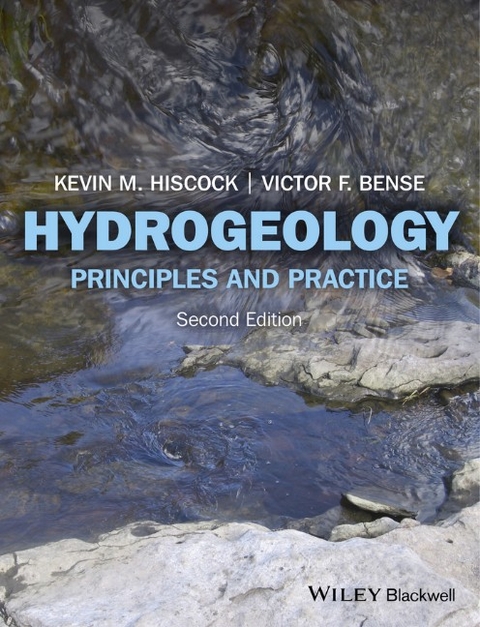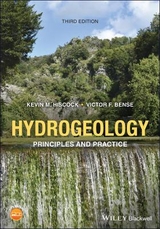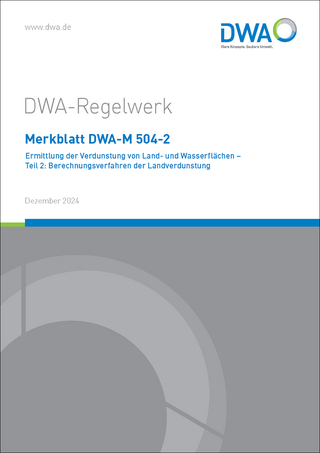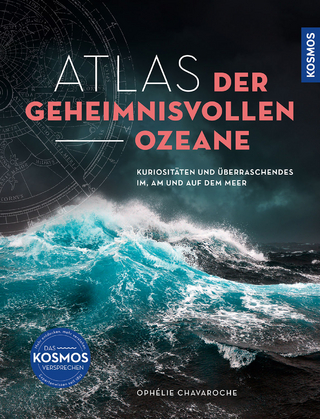
Hydrogeology
Wiley-Blackwell (Verlag)
978-0-470-65663-1 (ISBN)
- Titel erscheint in neuer Auflage
- Artikel merken
The last chapter discusses groundwater resources and environmental management, and examines the role of groundwater in integrated river basin management, including an assessment of possible adaptation responses to the impacts of climate change. Throughout the text, boxes and a set of colour plates drawn from the authors teaching and research experience are used to explain special topics and to illustrate international case studies ranging from transboundary aquifers and submarine groundwater discharge to the over-pressuring of groundwater in sedimentary basins. The appendices provide conversion tables and useful reference material, and include review questions and exercises, with answers, to help develop the reader s knowledge and problem-solving skills in hydrogeology. This accessible textbook is essential reading for undergraduate and graduate students primarily in earth sciences, environmental sciences and physical geography with an interest in hydrogeology or groundwater science.
The book will also find use among practitioners in hydrogeology, soil science, civil engineering and planning who are involved in environmental and resource protection issues requiring an understanding of groundwater. Additional resources can be found at: www.wiley.com/go/hiscock/hydrogeology
Kevin Hiscock is a Professor in the School of Environmental Sciences at the University of East Anglia, UK. He has over 30 years experience in teaching and research in hydrogeology, with interdisciplinary interests in hydrochemistry, environmental isotopes and the impacts of land use and climate change on groundwater resources at regional and global scales. Victor Bense is a Senior Lecturer in the School of Environmental Sciences at the University of East Anglia, UK. He has over 15 years experience in teaching and research in hydrogeology, with specialist interests in the impact of shallow fault zones in unconsolidated sediments on groundwater flow and the hydrogeology of arctic regions under changing climate.
List of colour plates, xi List of boxes, xiv Preface to the second edition, xvi Preface to the first edition, xvii Acknowledgements, xviii Symbols and abbreviations, xix About the companion website, xxiii 1. Introduction, 1 1.1 Scope of this book, 1 1.2 What is hydrogeology?, 2 1.3 Early examples of groundwater exploitation, 3 1.4 History of hydrogeology, 5 1.5 The water cycle, 10 1.6 Groundwater as a natural resource, 12 1.7 Management and protection of groundwater resources in the United Kingdom, 20 1.8 European Union Water Framework Directive, 21 1.9 Management and protection of groundwater resources in the United States, 22 1.10 Groundwater resources in developing countries, 23 1.11 Future challenges for groundwater management, 25 Further reading, 26 References, 26 2. Physical hydrogeology, 29 2.1 Introduction, 29 2.2 Porosity, 29 2.3 Hydraulic conductivity, 31 2.4 Isotropy and homogeneity, 33 2.5 Aquifers, aquitards and aquicludes, 33 2.6 Darcy s Law, 35 2.6.1 Hydraulic properties of fractured rocks, 38 2.6.2 Karst aquifer properties, 41 2.7 Groundwater potential and hydraulic head, 43 2.8 Interpretation of hydraulic head and groundwater conditions, 44 2.8.1 Groundwater flow direction, 44 2.8.2 Water table and potentiometric surface maps, 46 2.8.3 Types of groundwater conditions, 53 2.9 Transmissivity and storativity of confined aquifers, 57 2.9.1 Release of water from confined aquifers, 58 2.10 Transmissivity and specific yield of unconfined aquifers, 66 2.11 Equations of groundwater flow, 67 2.11.1 Steady-state saturated flow, 67 2.11.2 Transient saturated flow, 68 2.11.3 Transient unsaturated flow, 68 2.12 Analytical solution of one-dimensional groundwater flow problems, 69 2.13 Groundwater flow patterns, 74 2.14 Classification of springs and intermittent streams, 81 2.15 Transboundary aquifer systems, 86 2.16 Submarine groundwater discharge, 92 2.17 Groundwater resources of the world, 97 2.18 Hydrogeological environments of the United Kingdom, 99 2.18.1 Sedimentary rocks, 99 2.18.2 Metamorphic rocks, 104 2.18.3 Igneous rocks, 105 Further reading, 105 References, 105 3. Groundwater and geological processes, 109 3.1 Introduction, 109 3.2 Geological processes driving fluid flow, 109 3.3 Topography-driven flow in the context of geological processes, 110 3.4 Compaction-driven fluid flow, 110 3.5 Variable-density driven fluid flow, 114 3.5.1 Salinity gradients leading to variable-density flow, 114 3.5.2 Hydrothermal systems driven by variable-density flow, 119 3.6 Regional groundwater flow systems driven predominantly by variable-density flow, 120 3.6.1 Fluctuating sea-level and its impact on the distribution of groundwater salinity in coastal areas, 120 3.6.2 Brines in continental aquifers, 126 3.7 Regional groundwater flow systems driven predominantly by shifting topography and stress changes, 126 3.7.1 Mountain building and erosion, 127 3.7.2 Impact of glaciations on regional hydrogeology, 127 3.8 Coupling and relative importance of processes driving fluid flow, 133 Further reading, 133 References, 134 4. Chemical hydrogeology, 135 4.1 Introduction, 135 4.2 Properties of water, 135 4.3 Chemical composition of groundwater, 137 4.4 Sequence of hydrochemical evolution of groundwater, 139 4.5 Groundwater sampling and graphical presentation of hydrochemical data, 140 4.6 Concept of chemical equilibrium, 151 4.6.1 Kinetic approach to chemical equilibrium, 151 4.6.2 Energetic approach to chemical equilibrium, 152 4.7 Carbonate chemistry of groundwater, 154 4.8 Adsorption and ion exchange, 165 4.9 Redox chemistry, 172 4.10 Groundwater in crystalline rocks, 181 Further reading, 188 References, 188 5. Environmental isotope hydrogeology, 191 5.1 Introduction, 191 5.2 Stable isotope chemistry and nomenclature, 191 5.3 Stable isotopes of water, 192 5.4 Age dating of groundwater, 198 5.4.1 Law of radioactive decay, 198 5.4.2 14C dating, 198 5.4.3 36Cl dating, 202 5.4.4 Tritium dating, 202 5.4.5 3H/3He dating, 205 5.5 Noble gases, 206 Further reading, 209 References, 209 6. Groundwater and catchment processes, 211 6.1 Introduction, 211 6.2 Water balance equation, 211 6.3 Precipitation and evapotranspiration, 213 6.3.1 Precipitation measurement, 213 6.3.2 Evapotranspiration measurement and estimation, 215 6.4 Soil water and infiltration, 219 6.4.1 Soil moisture content and soil water potential, 219 6.4.2 Calculation of drainage and evaporation losses, 223 6.4.3 Infiltration theory and measurement, 225 6.5 Recharge estimation, 227 6.5.1 Borehole hydrograph method, 228 6.5.2 Soil moisture budget method, 228 6.5.3 Chloride budget method, 230 6.5.4 Temperature profile method, 230 6.6 Stream gauging techniques, 233 6.6.1 Velocity area methods, 237 6.6.1.1 Surface floats, 237 6.6.1.2 Current metering, 238 6.6.1.3 Acoustic Doppler current profiler, 239 6.6.2 Dilution gauging, 242 6.6.3 Ultrasonic, electromagnetic and integrating float methods, 243 6.6.4 Slope-area method, 244 6.6.5 Weirs and flumes, 245 6.7 Hydrograph analysis, 246 6.7.1 Quickflow and baseflow separation, 247 6.7.2 Unit hydrograph theory, 249 6.8 Surface water groundwater interaction, 253 6.8.1 Temperature-based methods of detection, 256 6.8.2 Simulating river flow depletion, 257 6.8.2.1 Analytical solutions, 257 6.8.2.2 Catchment resource modelling, 258 Further reading, 262 References, 262 7. Groundwater investigation techniques, 265 7.1 Introduction, 265 7.2 Measurement and interpretation of groundwater level data, 265 7.2.1 Water level measurement, 265 7.2.2 Well and borehole design and construction methods, 266 7.2.3 Borehole hydrographs and barometric efficiency, 268 7.2.4 Construction of groundwater level contour maps, 272 7.3 Field estimation of aquifer properties, 272 7.3.1 Piezometer tests, 272 7.3.2 Pumping tests, 273 7.3.2.1 Thiem equilibrium method, 275 7.3.2.2 Theis non-equilibrium method, 276 7.3.2.3 Cooper Jacob straight-line method, 277 7.3.2.4 Recovery test method, 282 7.3.2.5 Principle of superposition of drawdown, 283 7.3.2.6 Leaky, unconfined and bounded aquifer systems, 284 7.3.3 Tracer tests, 287 7.3.4 Geophysical methods, 292 7.4 Remote sensing methods, 295 7.5 Groundwater modelling, 298 Further reading, 301 References, 301 8. Groundwater quality and contaminant hydrogeology, 304 8.1 Introduction, 304 8.2 Water quality standards, 304 8.2.1 Water hardness, 306 8.2.2 Irrigation water quality, 309 8.3 Transport of contaminants in groundwater, 311 8.3.1 Transport of non-reactive dissolved contaminants, 311 8.3.1.1 One-dimensional solute transport equation, 314 8.3.2 Transport of reactive dissolved contaminants, 315 8.3.3 Transport of non-aqueous phase liquids, 327 8.3.3.1 Hydrophobic sorption of non-polar organic compounds, 329 8.3.4 Effects of density and heterogeneity, 333 8.4 Sources of groundwater contamination, 334 8.4.1 Urban and industrial contaminants, 334 8.4.2 Municipal landfill, domestic and cemetery wastes, 343 8.4.3 Agricultural contaminants, 350 8.4.4 Saline water intrusion in coastal aquifers, 356 Further reading, 362 References, 362 9. Groundwater pollution remediation and protection, 366 9.1 Introduction, 366 9.2 Groundwater pollution remediation techniques, 366 9.2.1 Pump-and-treat, 367 9.2.2 Permeable reactive barriers, 372 9.2.3 Monitored natural attenuation, 373 9.3 Groundwater pollution protection strategies in industrialized countries, 379 9.3.1 Groundwater vulnerability mapping and aquifer resource protection, 379 9.3.2 Source protection zones, 380 9.3.3 Risk assessment methods, 386 9.3.4 Spatial planning and groundwater protection, 387 9.4 Groundwater protection strategies in developing countries, 392 Further reading, 397 References, 397 10. Groundwater resources and environmental management, 400 10.1 Introduction, 400 10.2 Groundwater resources schemes, 400 10.2.1 Large-scale groundwater development schemes, 400 10.2.2 Regional-scale groundwater development schemes, 404 10.2.3 Artificial storage and recovery schemes, 406 10.2.4 Riverbank filtration schemes, 410 10.2.5 Horizontal well schemes, 416 10.3 Wetland hydrogeology, 416 10.4 Climate change and groundwater resources, 424 10.4.1 Adaptation to climate change, 435 Further reading, 440 References, 440 Appendices, 444 1. Conversion factors, 444 2. Properties of water in the range 0 100 C, 445 3. The geological timescale, 446 4. Symbols, atomic numbers and atomic weights, 447 5. Composition of seawater and rainwater, 449 References, 452 6. Values of W(u) for various values of u, 453 7. Values of q/Q and v/Qt corresponding to selected values of t/F for use in computing the rate and volume of stream depletion by wells and boreholes, 454 8. Complementary error function, 455 9. Drinking water quality standards and Lists I and II Substances, 456 10. Review questions and exercises, 462 References, 504 Index, 505
| Verlagsort | Hoboken |
|---|---|
| Sprache | englisch |
| Maße | 186 x 244 mm |
| Gewicht | 1584 g |
| Themenwelt | Naturwissenschaften ► Geowissenschaften ► Hydrologie / Ozeanografie |
| ISBN-10 | 0-470-65663-8 / 0470656638 |
| ISBN-13 | 978-0-470-65663-1 / 9780470656631 |
| Zustand | Neuware |
| Informationen gemäß Produktsicherheitsverordnung (GPSR) | |
| Haben Sie eine Frage zum Produkt? |
aus dem Bereich



